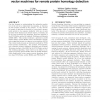Free Online Productivity Tools
i2Speak
i2Symbol
i2OCR
iTex2Img
iWeb2Print
iWeb2Shot
i2Type
iPdf2Split
iPdf2Merge
i2Bopomofo
i2Arabic
i2Style
i2Image
i2PDF
iLatex2Rtf
Sci2ools
120
click to vote
RECOMB
2002
Springer
2002
Springer
Combining pairwise sequence similarity and support vector machines for remote protein homology detection
One key element in understanding the molecular machinery of the cell is to understand the meaning, or function, of each protein encoded in the genome. A very successful means of inferring the function of a previously unannotated protein is via sequence similarity with one or more proteins whose functions are already known. Currently, one of the most powerful such homology detection methods is the SVM-Fisher method of Jaakkola, Diekhans and Haussler (ISMB 2000). This method combines a generative, profile hidden Markov model (HMM) with a discriminative classification algorithm known as a support vector machine (SVM). The current work presents an alternative method for SVMbased protein classification. The method, SVM-pairwise, uses a pairwise sequence similarity algorithm such as SmithWaterman in place of the HMM in the SVM-Fisher method. The resulting algorithm, when tested on its ability to recognize previously unseen families from the SCOP database, yields significantly better remote ...
Computational Biology | Computational Molecular Biology | RECOMB 2002 | Sixth International Conference | Support Vector Machine |
Related Content
| Added | 03 Dec 2009 |
| Updated | 03 Dec 2009 |
| Type | Conference |
| Year | 2002 |
| Where | RECOMB |
| Authors | Li Liao, William Stafford Noble |
Comments (0)

